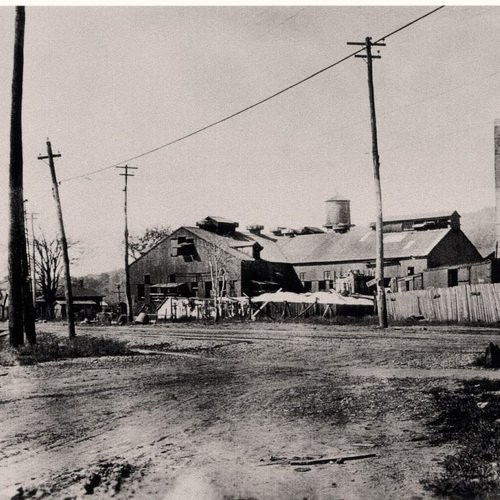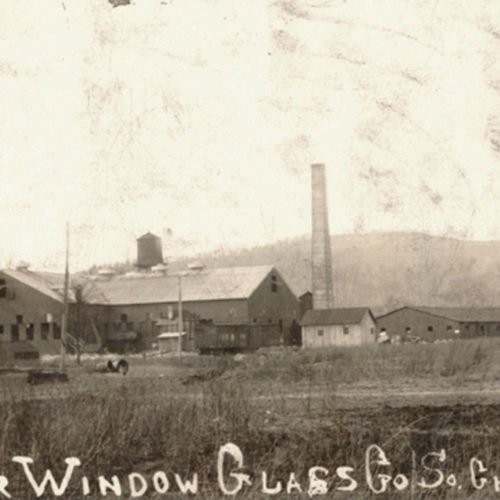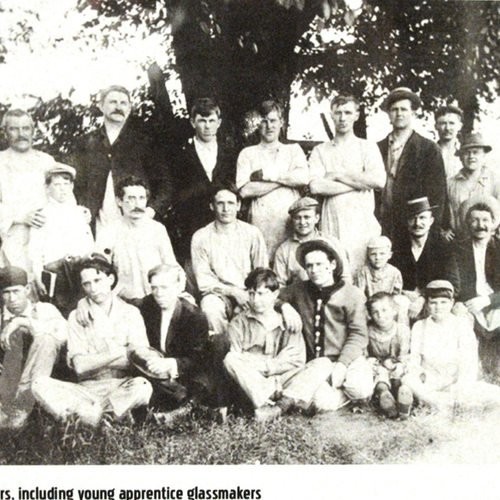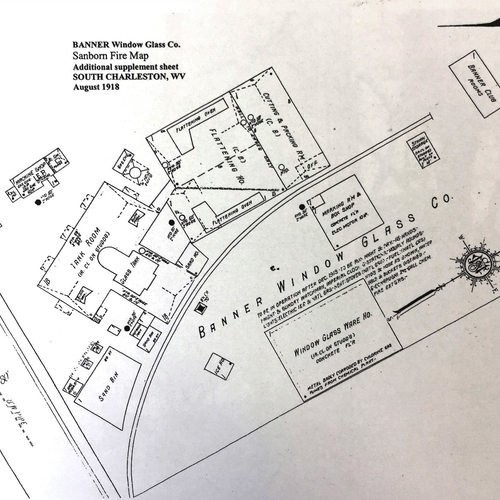Banner Glass Company
Introduction
Text-to-speech Audio
Images
A view of the Banner Window Glass Company, one of the earliest industrial endeavors of the brand new city. It brought over 200 new settlers to the Kanawha Valley, most of them first generation

Photos of the Banner Glass Company depict the second factory--the first having burned down after only a day of operation in 1907.

Young apprentice glassmakers. Apprentices were often relatives of other men working in the factory, as the European guild system gave the existing membership final say on allowing in new members.

A map of the Banner Glass site. The factory was located on the site of the current Rite Aid, with its entrance in nearly the same spot. Another Belgian glass company, Dunkirk, was located at the present site of the Dow Chemical headquarters.

Backstory and Context
Text-to-speech Audio
The history of the modern city of South Charleston dates to the arrival of immigrant glassworkers and their families in 1907. Enticed by free land and free natural gas—a key resource in glassmaking, and one which had run out in their erstwhile hometowns in Indiana—a thriving community of Belgians relocated from Indiana to ply their trade in the Kanawha Valley.
Around the turn of the 20th century, the Kanawha Land Company, headed by former West Virginia Governor William A. MacCorkle, perhaps prescient of the industries that would later thrive in the area, had acquired most of the bottomland on the south side of the Kanawha River, just west of Charleston. MacCorkle, however, was having trouble attracting residents.
Increasingly desperate to return more on the substantial amount of land they'd invested in, MacCorkle convinced his business partners to incentivize: free real estate and two years of natural gas would be granted to any company willing to relocate to the still-hypothetical town of South Charleston.
MacCorkle was in luck. Two glassmaking companies in Indiana were in need of exactly what the Kanawha Land Company was offering. In the spring of 1907, Felix Dandois, Aimer Lefevre, and Alfred Gilbert, representing Banner Window Glass of Shirley, Indiana, accepted MacCorkle's offer. Having first inspected potential sites in Huntington, Milton, and Clarksburg, approximately 40 Belgian and French families made the trek southward to the Kanawha Valley. They arrived to find their new hometown consisted of a mere twelve houses.
The Banner Window Glass factory was built near the Kanawha River, beside an ancient Adena burial mound. (Today, a Rite-Aid store stands at the entrance to the former plant.) It took three weeks after construction was completed for the furnaces to achieve the necessary temperature for glass production. On December 12, 1907, Banner Window Glass manufactured its first piece of flat glass. The celebration was short-lived, as the factory burned down the next day. Somehow the Belgians rebuilt the plant and restarted production eight months later.
Banner Window Glass was a cooperative derived from the European guild system, where laborers held an active stake in the operation of the factory. From the perspective of a pre-Henry Ford world, where mass production did not yet hold unshakeable sway over manufacturing processes, this produced a more cost-efficient product and generated greater pay for the workers.
The guilds included a strong tradition of apprenticeship, wherein young men trained with more experienced workers for years to perfect particular skills within a trade. With such tightly-controlled membership, guilds often developed into fraternity-like entities where invitation was the only means of entrance and in many cases, family members were the only aspirants allowed to join. Crafts like glassmaking became family secrets, allowing companies like Banner to maintain control over portions of the market.
But in 1917, commercial competition in the area heated up as the Libby Owens Glass Company built a more modern, mechanized facility across the Kanawha in Charleston. Mechanization allowed workers to be trained faster, and products to be manufactured more quickly. The Belgians and their more craftsmanlike approach were soon unable to keep pace with Libby Owens' assembly-line methodology.
"Glass blowing went down in history and the block and blowers' pipe were laid away. A glass cutter could still follow his trade, but his fellow workers had to learn a new trade."5
Despite the absence of Banner Glass and its nearby Belgian sister company, Dunkirk Glass Company (which sold to Libby Owens in 1928), the presence of Belgian tradition continues to impact the South Charleston community--many local residents are descended from those original Belgians from Indiana, and a Belgian Festival was celebrated annually into the 1990s. Near the old site of Banner Glass, the South Charleston Interpretive Center currently hosts a vivid exhibit from the South Charleston Museum about Belgian glass manufacturing and the lives of the early Belgian workers.
Sources
1. Barkey, Frederick. Cinderheads in the Hills: The Belgian Window Glass Workers of West Virginia. Charleston: West Virginia Humanities Council, 1988.
2. Fones-Wolf, Ken "Belgians." e-WV: The West Virginia Encyclopedia. 21 December 2010. Web. 21 November 2017.
3. Melton, Nelle S. "The History of South Charleston." . Published 1939. West Virginia University, Morgantown4. Baumgardner, Stan. "In the Beginning: South Charleston’s Belgian Roots." Golden Seal Magazine. Golden Seal Magazine. http://www.wvculture.org/goldenseal/winter11/Belgian.html
5. The History of South Charleston. Edition 2nd. Charleston, WV. The Printing Press, Ltd., 2008. pp.15
